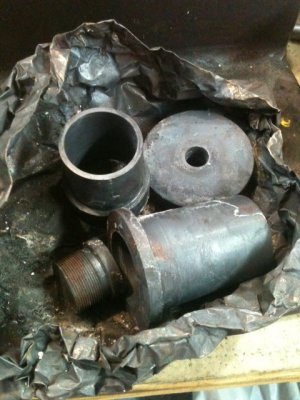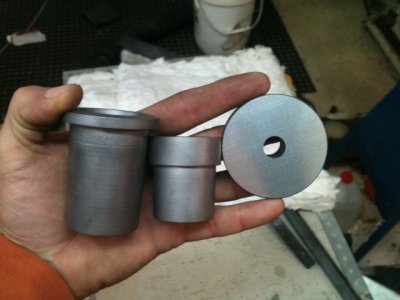- Joined
- Nov 16, 2012
- Messages
- 5,596
Dinner is served... and here's some dinner conversation.
When I heat treat these for the full hardening, I wrap each piece in several pieces of paper towel and toss them in a stainless steel bag. As the oven warms up, most of the paper burns which depletes the oxygen in the oven which prevents oxidation and decarburization. This then fills the oven mostly with carbon dioxide and carbon monoxide. As the oven continues to heat, the gasses expand and are expelled from the box. Since the temperatures are ever increasing, outside oxygen tends not to get back inside the box. In this case, there was more than enough paper to deplete most of the air. When the door was opened and the bag was opened, much of the paper effectively turned into charcoal which immediately burns with a flame as soon as the air hits it.
From there, the pieces are immediately tossed into the brine. This minimizes the amount of time they're exposed to air. Metal only oxidizes and decarburizes in open air and when at temperatures above 1000F.
Once they cool in the brine down to 150-200F, I put them in an awaiting toaster oven set at 150F and keep them there until the main oven cools down to the tempering temperature. It takes about 1/2 hour for the oven to cool to typical tempering temperatures. The metal must never cool below 150F and the temper must take place within 1 hour of the quench.
Tempering temperature was chosen to be 650F because I desired this metal to be 45 RC. This was looked-up in the charts in my cook book. I chose RC 45 because I know my spindle is RC 50 and it makes sense to have these kinds of attachments a little softer than the main equipment.
Here they are right as they temper soaked for 1 hour. I had a few more pieces (all 1045 material) in this batch. Because of it's size, the big round piece really needed to be in the oven during the heat treating phase for longer than it was kept but, it's not a critical part and I didn't want to over-cook the two taper adapters -so I pulled the batch all at the same time. The big round piece is about 1" thick. Nothing on the taper adapters has a cross section more than 1/4". The big piece should have soaked for an hour but everything was pulled after 1/2 hour.

After the temper, the parts were air cooled to room temperature to allow them to pass below the Martenizing phase. On the big round piece, I did a quick surface grind and did a hardness test. It's reading a very solid Rockwell 43C. It's two points low because it didn't heat soak long enough. I don't want to put a ding mark in the taper adapters but, I can all but guarantee they are RC 45 as planned (smaller pieces get harder, faster than bigger pieces).
Here they are just quickly sandblasted. I checked all the dimensions once they were room temperature. Absolutely, positively no differences in readings in any length or round dimension.

Ray
EDIT: Moral of the story: If you follow the procedures, practice your techniques and use good thermometers, you can do dead-on precision heat treating in a home shop. Most important, almost all forms of warpage and undue shrinkage are vastly minimized (if not completely eliminated) using good procedures. These are the benefits of modern textbooks and years of work by metallurgists...


When I heat treat these for the full hardening, I wrap each piece in several pieces of paper towel and toss them in a stainless steel bag. As the oven warms up, most of the paper burns which depletes the oxygen in the oven which prevents oxidation and decarburization. This then fills the oven mostly with carbon dioxide and carbon monoxide. As the oven continues to heat, the gasses expand and are expelled from the box. Since the temperatures are ever increasing, outside oxygen tends not to get back inside the box. In this case, there was more than enough paper to deplete most of the air. When the door was opened and the bag was opened, much of the paper effectively turned into charcoal which immediately burns with a flame as soon as the air hits it.
From there, the pieces are immediately tossed into the brine. This minimizes the amount of time they're exposed to air. Metal only oxidizes and decarburizes in open air and when at temperatures above 1000F.
Once they cool in the brine down to 150-200F, I put them in an awaiting toaster oven set at 150F and keep them there until the main oven cools down to the tempering temperature. It takes about 1/2 hour for the oven to cool to typical tempering temperatures. The metal must never cool below 150F and the temper must take place within 1 hour of the quench.
Tempering temperature was chosen to be 650F because I desired this metal to be 45 RC. This was looked-up in the charts in my cook book. I chose RC 45 because I know my spindle is RC 50 and it makes sense to have these kinds of attachments a little softer than the main equipment.
Here they are right as they temper soaked for 1 hour. I had a few more pieces (all 1045 material) in this batch. Because of it's size, the big round piece really needed to be in the oven during the heat treating phase for longer than it was kept but, it's not a critical part and I didn't want to over-cook the two taper adapters -so I pulled the batch all at the same time. The big round piece is about 1" thick. Nothing on the taper adapters has a cross section more than 1/4". The big piece should have soaked for an hour but everything was pulled after 1/2 hour.

After the temper, the parts were air cooled to room temperature to allow them to pass below the Martenizing phase. On the big round piece, I did a quick surface grind and did a hardness test. It's reading a very solid Rockwell 43C. It's two points low because it didn't heat soak long enough. I don't want to put a ding mark in the taper adapters but, I can all but guarantee they are RC 45 as planned (smaller pieces get harder, faster than bigger pieces).
Here they are just quickly sandblasted. I checked all the dimensions once they were room temperature. Absolutely, positively no differences in readings in any length or round dimension.

Ray
EDIT: Moral of the story: If you follow the procedures, practice your techniques and use good thermometers, you can do dead-on precision heat treating in a home shop. Most important, almost all forms of warpage and undue shrinkage are vastly minimized (if not completely eliminated) using good procedures. These are the benefits of modern textbooks and years of work by metallurgists...



